Yanyan Shen
UAV-Enabled Fluid Antenna Systems for Multi-Target Wireless Sensing over LAWCNs
Sep 26, 2025Abstract:Fluid antenna system (FAS) is emerging as a key technology for enhancing spatial flexibility and sensing accuracy in future wireless systems. This paper investigates an unmanned aerial vehicle (UAV)-enabled FAS for multi-target wireless sensing in low-altitude wireless consumer networks (LAWCNs) for achieving the low-altitude economy (LAE) missions. We formulate an optimization problem aimed at minimizing the average Cram\'er-Rao bound (CRB) for multiple target estimations. To tackle this non-convex problem, an efficient alternating optimization (AO) algorithm is proposed, which jointly optimizes the UAV trajectory, the antenna position of the transmit fluid antennas (FAs) and the receive FAs, and the transmit beamforming at the UAV. Simulation results demonstrate significant performance improvements in estimation accuracy and sensing reliability compared to conventional schemes, e.g., the fixed position antenna scheme. The proposed system achieves enhanced sensing performance through adaptive trajectory design and beamforming, alongside effective interference suppression via the flexible FAS antenna repositioning, underscoring its practical potential for precision sensing in the UAV-enabled LAWCNs.
RSMA-Enhanced Data Collection in RIS-Assisted Intelligent Consumer Transportation Systems
Sep 11, 2025Abstract:This paper investigates the data collection enhancement problem in a reconfigurable intelligent surface (RIS)-empowered intelligent consumer transportation system (ICTS). We propose a novel framework where a data center (DC) provides energy to pre-configured roadside unit (RSU) pairs during the downlink stage. While in the uplink stage, these RSU pairs utilize a hybrid rate-splitting multiple access (RSMA) and time-division multiple access (TDMA) protocol to transmit the processed data to the DC, while simultaneously performing local data processing using the harvested energy. Our objective is to maximize the minimal processed data volume of the RSU pairs by jointly optimizing the RIS downlink and uplink phase shifts, the transmit power of the DC and RSUs, the RSU computation resource allocation, and the time slot allocation. To address the formulated non-convex problem, we develop an efficient iterative algorithm integrating alternating optimization and sequential rank-one constraint relaxation methods. Extensive simulations demonstrate that the proposed algorithm significantly outperforms baseline schemes under diverse scenarios, validating its effectiveness in enhancing the data processing performance for intelligent transportation applications.
QoS-Aware Integrated Sensing, Communication, and Control with Movable Antenna
Aug 11, 2025Abstract:Integrated sensing, communication, and control (ISCC) has emerged as a key enabler for low-altitude wireless networks with enhanced adaptability through resource allocation co-design and intelligent environment awareness. However, dynamic interference and channel attenuation constrain the potential of the ISCC system. To address this challenge, we propose a novel movable antenna-empowered ISCC system. An achievable data rate maximization problem is formulated while guaranteeing the sensing and control quality-of-service (QoS) by optimizing the positions of the antennas and the beamforming strategy for communication, sensing, and control co-design. An efficient alternating optimization (AO)-based algorithm is proposed to solve the highly coupled non-convex problem. Numerical results demonstrate that the proposed AO-based algorithm achieves substantial gains in the achievable data rate and the control QoS compared with benchmark schemes.
Latency Minimization for Multi-AAV-Enabled ISCC Systems with Movable Antenna
Aug 07, 2025Abstract:This paper investigates an autonomous aerial vehicle (AAV)-enabled integrated sensing, communication, and computation system, with a particular focus on integrating movable antennas (MAs) into the system for enhancing overall system performance. Specifically, multiple MA-enabled AVVs perform sensing tasks and simultaneously transmit the generated computational tasks to the base station for processing. To minimize the maximum latency under the sensing and resource constraints, we formulate an optimization problem that jointly coordinates the position of the MAs, the computation resource allocation, and the transmit beamforming. Due to the non-convexity of the objective function and strong coupling among variables, we propose a two-layer iterative algorithm leveraging particle swarm optimization and convex optimization to address it. The simulation results demonstrate that the proposed scheme achieves significant latency improvements compared to the baseline schemes.
Coordinated Beamforming for RIS-Empowered ISAC Systems over Secure Low-Altitude Networks
May 30, 2025Abstract:Emerging as a cornerstone for next-generation wireless networks, integrated sensing and communication (ISAC) systems demand innovative solutions to balance spectral efficiency and sensing accuracy. In this paper, we propose a coordinated beamforming framework for a reconfigurable intelligent surface (RIS)-empowered ISAC system, where the active precoding at the dual-functional base station (DFBS) and the passive beamforming at the RIS are jointly optimized to provide communication services for legitimate unmanned aerial vehicles (UAVs) while sensing the unauthorized UAVs. The sum-rate of all legitimate UAVs are maximized, while satisfying the radar sensing signal-to-noise ratio requirements, the transmit power constraints, and the reflection coefficients of the RIS. To address the inherent non-convexity from coupled variables, we propose a low-complexity algorithm integrating fractional programming with alternating optimization, featuring convergence guarantees. Numerical results demonstrate that the proposed algorithm achieves higher data rate compared to disjoint optimization benchmarks. This underscores RIS's pivotal role in harmonizing communication and target sensing functionalities for low-altitude networks.
Less is More: Unlocking Specialization of Time Series Foundation Models via Structured Pruning
May 29, 2025Abstract:Scaling laws motivate the development of Time Series Foundation Models (TSFMs) that pre-train vast parameters and achieve remarkable zero-shot forecasting performance. Surprisingly, even after fine-tuning, TSFMs cannot consistently outperform smaller, specialized models trained on full-shot downstream data. A key question is how to realize effective adaptation of TSFMs for a target forecasting task. Through empirical studies on various TSFMs, the pre-trained models often exhibit inherent sparsity and redundancy in computation, suggesting that TSFMs have learned to activate task-relevant network substructures to accommodate diverse forecasting tasks. To preserve this valuable prior knowledge, we propose a structured pruning method to regularize the subsequent fine-tuning process by focusing it on a more relevant and compact parameter space. Extensive experiments on seven TSFMs and six benchmarks demonstrate that fine-tuning a smaller, pruned TSFM significantly improves forecasting performance compared to fine-tuning original models. This "prune-then-finetune" paradigm often enables TSFMs to achieve state-of-the-art performance and surpass strong specialized baselines.
In-Context Adaptation to Concept Drift for Learned Database Operations
May 07, 2025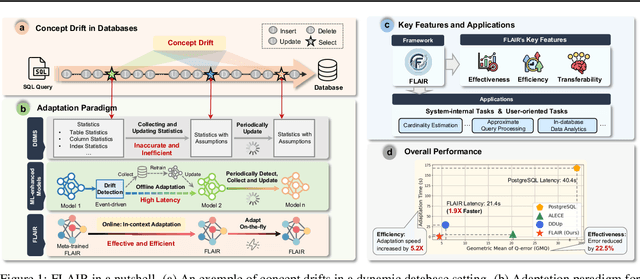
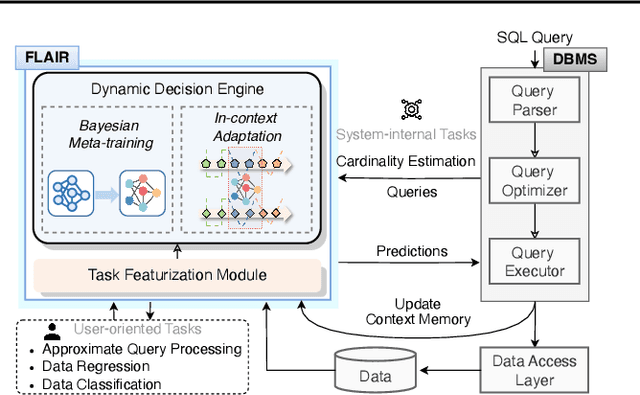
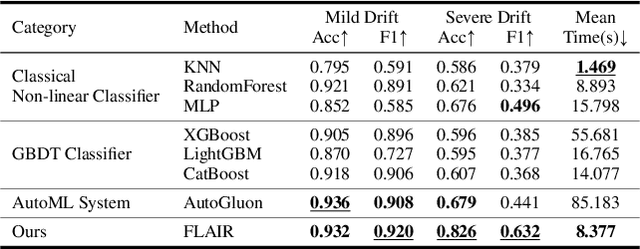
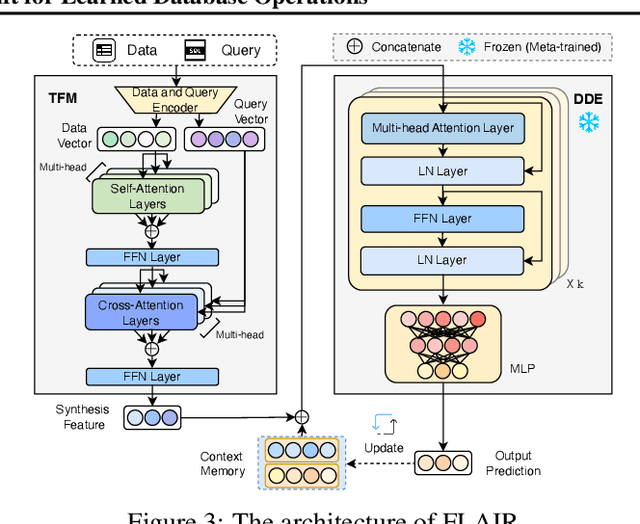
Abstract:Machine learning has demonstrated transformative potential for database operations, such as query optimization and in-database data analytics. However, dynamic database environments, characterized by frequent updates and evolving data distributions, introduce concept drift, which leads to performance degradation for learned models and limits their practical applicability. Addressing this challenge requires efficient frameworks capable of adapting to shifting concepts while minimizing the overhead of retraining or fine-tuning. In this paper, we propose FLAIR, an online adaptation framework that introduces a new paradigm called \textit{in-context adaptation} for learned database operations. FLAIR leverages the inherent property of data systems, i.e., immediate availability of execution results for predictions, to enable dynamic context construction. By formalizing adaptation as $f:(\mathbf{x} \,| \,\mathcal{C}_t) \to \mathbf{y}$, with $\mathcal{C}_t$ representing a dynamic context memory, FLAIR delivers predictions aligned with the current concept, eliminating the need for runtime parameter optimization. To achieve this, FLAIR integrates two key modules: a Task Featurization Module for encoding task-specific features into standardized representations, and a Dynamic Decision Engine, pre-trained via Bayesian meta-training, to adapt seamlessly using contextual information at runtime. Extensive experiments across key database tasks demonstrate that FLAIR outperforms state-of-the-art baselines, achieving up to 5.2x faster adaptation and reducing error by 22.5% for cardinality estimation.
A Framework for Elastic Adaptation of User Multiple Intents in Sequential Recommendation
Apr 30, 2025Abstract:Recently, substantial research has been conducted on sequential recommendation, with the objective of forecasting the subsequent item by leveraging a user's historical sequence of interacted items. Prior studies employ both capsule networks and self-attention techniques to effectively capture diverse underlying intents within a user's interaction sequence, thereby achieving the most advanced performance in sequential recommendation. However, users could potentially form novel intents from fresh interactions as the lengths of user interaction sequences grow. Consequently, models need to be continually updated or even extended to adeptly encompass these emerging user intents, referred as incremental multi-intent sequential recommendation. % We refer to this problem as incremental multi-intent sequential recommendation, which has not yet been well investigated in the existing literature. In this paper, we propose an effective Incremental learning framework for user Multi-intent Adaptation in sequential recommendation called IMA, which augments the traditional fine-tuning strategy with the existing-intents retainer, new-intents detector, and projection-based intents trimmer to adaptively expand the model to accommodate user's new intents and prevent it from forgetting user's existing intents. Furthermore, we upgrade the IMA into an Elastic Multi-intent Adaptation (EMA) framework which can elastically remove inactive intents and compress user intent vectors under memory space limit. Extensive experiments on real-world datasets verify the effectiveness of the proposed IMA and EMA on incremental multi-intent sequential recommendation, compared with various baselines.
Feature Staleness Aware Incremental Learning for CTR Prediction
Apr 29, 2025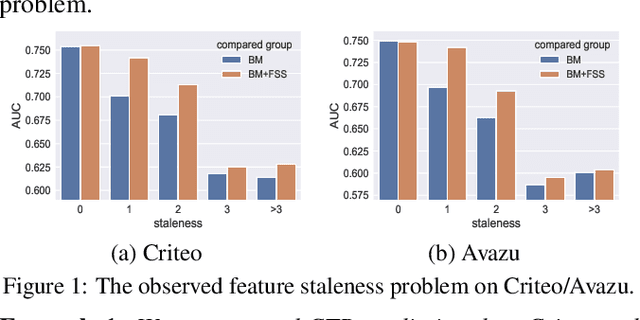
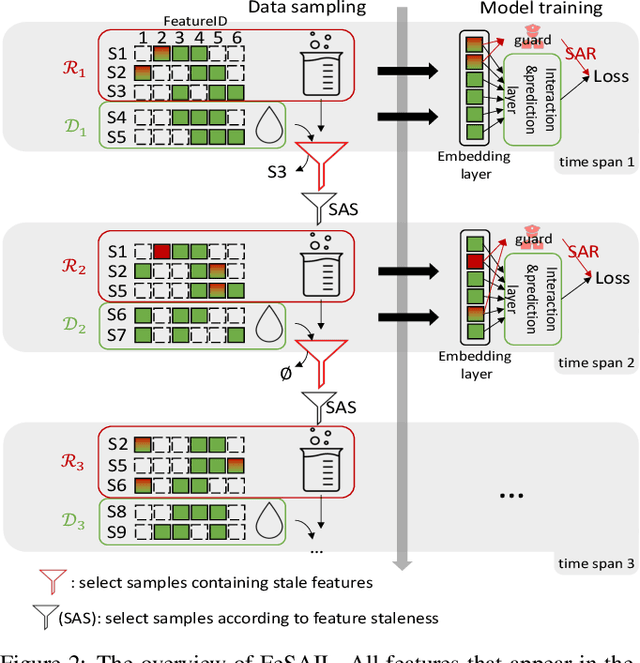
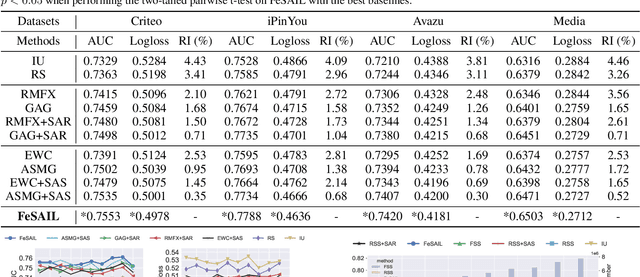
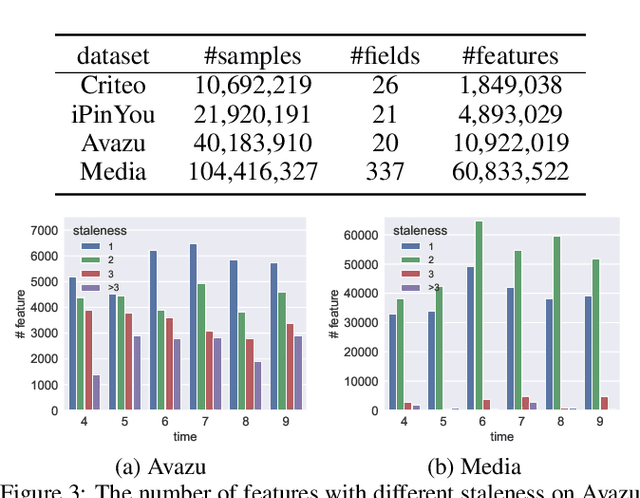
Abstract:Click-through Rate (CTR) prediction in real-world recommender systems often deals with billions of user interactions every day. To improve the training efficiency, it is common to update the CTR prediction model incrementally using the new incremental data and a subset of historical data. However, the feature embeddings of a CTR prediction model often get stale when the corresponding features do not appear in current incremental data. In the next period, the model would have a performance degradation on samples containing stale features, which we call the feature staleness problem. To mitigate this problem, we propose a Feature Staleness Aware Incremental Learning method for CTR prediction (FeSAIL) which adaptively replays samples containing stale features. We first introduce a staleness aware sampling algorithm (SAS) to sample a fixed number of stale samples with high sampling efficiency. We then introduce a staleness aware regularization mechanism (SAR) for a fine-grained control of the feature embedding updating. We instantiate FeSAIL with a general deep learning-based CTR prediction model and the experimental results demonstrate FeSAIL outperforms various state-of-the-art methods on four benchmark datasets.
Relative Contrastive Learning for Sequential Recommendation with Similarity-based Positive Pair Selection
Apr 27, 2025Abstract:Contrastive Learning (CL) enhances the training of sequential recommendation (SR) models through informative self-supervision signals. Existing methods often rely on data augmentation strategies to create positive samples and promote representation invariance. Some strategies such as item reordering and item substitution may inadvertently alter user intent. Supervised Contrastive Learning (SCL) based methods find an alternative to augmentation-based CL methods by selecting same-target sequences (interaction sequences with the same target item) to form positive samples. However, SCL-based methods suffer from the scarcity of same-target sequences and consequently lack enough signals for contrastive learning. In this work, we propose to use similar sequences (with different target items) as additional positive samples and introduce a Relative Contrastive Learning (RCL) framework for sequential recommendation. RCL comprises a dual-tiered positive sample selection module and a relative contrastive learning module. The former module selects same-target sequences as strong positive samples and selects similar sequences as weak positive samples. The latter module employs a weighted relative contrastive loss, ensuring that each sequence is represented closer to its strong positive samples than its weak positive samples. We apply RCL on two mainstream deep learning-based SR models, and our empirical results reveal that RCL can achieve 4.88% improvement averagely than the state-of-the-art SR methods on five public datasets and one private dataset.
 Add to Chrome
Add to Chrome Add to Firefox
Add to Firefox Add to Edge
Add to Edge